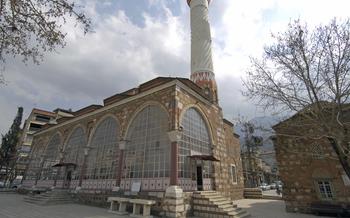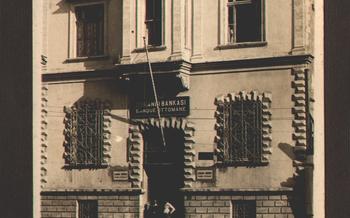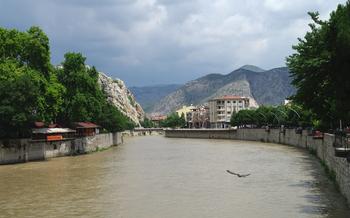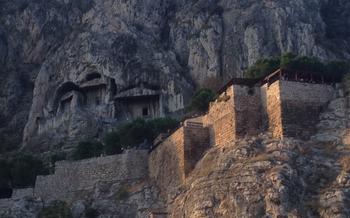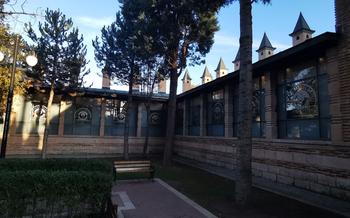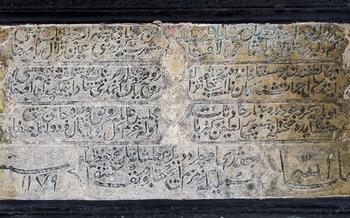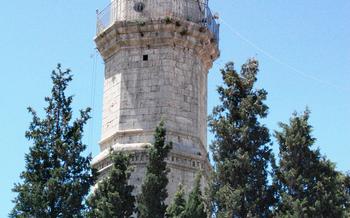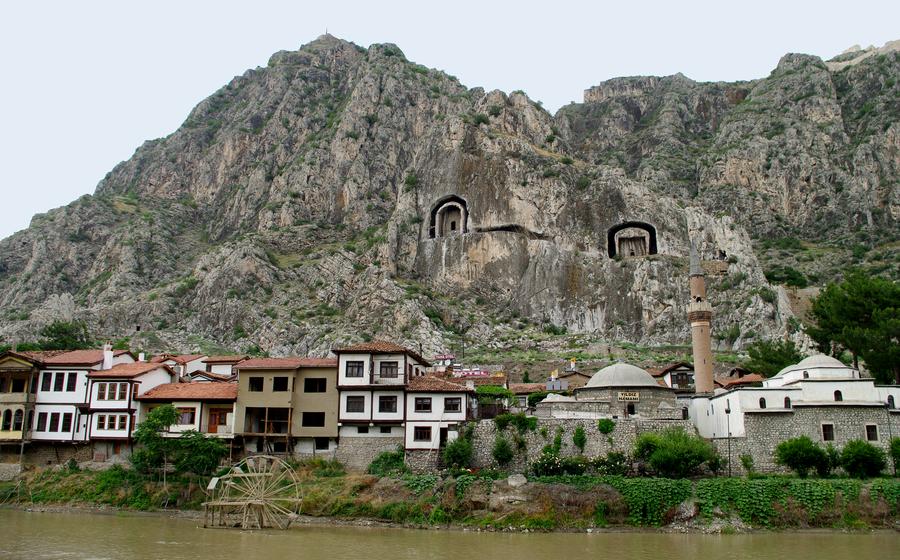
Hatuniye Mosque
- Historical Significance
- Unique Features
- Interior Beauty
- Symbol of Resilience
- Spiritual Atmosphere
- Local Traditions
- Historical Context
- Exploring the Surroundings
- Best Time to Visit
- Insider Perspective
- Dress Code and Etiquette
- Photography Tips
- Accessibility and Facilities
- Nearby Attractions
- Insider Tip: Unveiling Hidden Gems and Experiencing the Divine Call
Historical Significance
The Hatuniye Mosque stands as a testament to the rich history and cultural heritage of Turkey. Built in the 13th century during the Seljuk era, it was commissioned by the Seljuk Sultan Giyaseddin Keyhusrev II as a symbol of his devotion and power. The mosque's name, Hatuniye, translates to "Mosque of the Lady" and is believed to honor the sultan's wife or daughter, who played a significant role in its construction.
The mosque's architectural style showcases a harmonious blend of Seljuk and Ottoman influences. Its striking dome, adorned with intricate geometric patterns and turquoise tiles, reflects the Seljuk architectural style. The minaret, with its slender form and elegant balconies, is a testament to the Ottoman era's artistic prowess. The mosque's exterior is further embellished with ornate carvings and inscriptions, narrating stories from the Quran and Islamic history.
Culturally and religiously, the Hatuniye Mosque holds immense importance for the people of Amasya. It is not only a place of worship but also a symbol of unity, faith, and resilience. The mosque's enduring legacy and historical significance make it a must-visit destination for those seeking to delve into Turkey's cultural and spiritual heritage.
Unique Features
The Hatuniye Mosque proudly displays a distinctive dome that stands out amongst other structures in the city. Its elegant shape and intricate tilework create a visually stunning focal point. The mosque's minaret, a slender tower rising towards the sky, adds to its majestic presence. The combination of these architectural elements creates a harmonious silhouette that captivates visitors from afar.
The mosque's exterior is adorned with ornate carvings and inscriptions that showcase the artistry and craftsmanship of its builders. These intricate details add a layer of visual interest and provide glimpses into the history and culture of the period. The combination of architectural influences, including Seljuk and Ottoman styles, is evident in the mosque's design, reflecting Amasya's rich past as a cultural crossroads.
Interior Beauty
The interior of the Hatuniye Mosque is a testament to the artistic prowess of the Seljuk and Ottoman periods. The walls and dome are adorned with intricate tilework, featuring geometric patterns and floral motifs in vibrant hues of blue, green, and red. Calligraphic inscriptions, written in elegant Arabic script, adorn the mihrab, minbar, and other surfaces, adding to the mosque's spiritual ambiance.
The mihrab, a niche indicating the direction of Mecca, is a masterpiece of craftsmanship. It is intricately carved with geometric patterns and adorned with colorful tiles. The minbar, a pulpit from which the imam delivers sermons, is equally impressive, featuring fine carvings and delicate inlay work.
The spacious prayer hall can accommodate a large number of worshippers. The high ceiling and arched windows create a sense of grandeur and serenity, conducive to contemplation and prayer. The overall effect of the mosque's interior is one of awe and inspiration, leaving visitors with a lasting impression of its beauty and spirituality.
Symbol of Resilience
The Hatuniye Mosque has proudly endured the test of time, standing resiliently against numerous earthquakes that have ravaged the region. Its sturdy construction and architectural brilliance have allowed it to withstand these seismic events, emerging with minimal damage.
Throughout history, the mosque has undergone meticulous restoration efforts, ensuring its preservation for future generations. These efforts have not only focused on repairing structural damage but also on maintaining its original architectural features and intricate details.
As a result of these preservation endeavors, the Hatuniye Mosque continues to stand as a testament to its enduring legacy, symbolizing the resilience of both the structure itself and the faith it represents. It serves as a reminder of the importance of protecting and preserving our cultural heritage for the enjoyment and inspiration of generations to come.
Spiritual Atmosphere
Within the walls of the Hatuniye Mosque lies a sanctuary of serenity, inviting the faithful and visitors alike to immerse themselves in spiritual reflection. The air is pregnant with a palpable sense of tranquility, providing a sanctuary for those seeking solace and connection with the divine. Locals regard the mosque with deep reverence, cherishing it as a symbol of their faith and devotion. Its hallowed halls exude an aura that inspires and uplifts, leaving an enduring impression on all who step within its sacred space.
Local Traditions
Throughout the years, the Hatuniye Mosque has become an integral part of the local community's traditions and practices. During the holy month of Ramadan, the mosque hosts special prayers and gatherings, where worshippers come together to break their fast and seek spiritual guidance. During festivals and religious celebrations, the mosque serves as a central gathering point for community members to share their joy and express their devotion.
One unique tradition associated with the Hatuniye Mosque is the annual "Hıdrellez" festival, which takes place on May 6th. On this day, locals gather at the mosque and its surroundings to celebrate the arrival of spring and the renewal of nature. They engage in traditional rituals, such as tying colorful ribbons to trees and making wishes, symbolizing their hopes and aspirations for the coming year. These traditions showcase the deep connection between the mosque and the local community, highlighting its role as a symbol of faith, unity, and cultural heritage.
Historical Context
The Hatuniye Mosque stands as a testament to the rich historical tapestry of Amasya, a city that has served as a significant cultural and political center throughout the ages. Constructed during the reign of the Seljuk dynasty, which ruled over Anatolia from the 11th to the 14th century, the mosque embodies the architectural prowess and artistic sensibilities of this powerful empire. The Seljuks, known for their architectural innovations and patronage of the arts, left an enduring legacy in Amasya, with the Hatuniye Mosque serving as a prime example of their architectural prowess.
As the Ottoman Empire rose to prominence, Amasya continued to thrive as a cultural and administrative hub, and the Hatuniye Mosque remained a focal point of religious and communal life. The Ottomans, who ruled over Anatolia for more than six centuries, added their unique architectural touches to the mosque, blending Seljuk elements with their own distinctive style. This harmonious fusion of architectural influences reflects the rich cultural exchange that took place during this period, as the Ottomans incorporated elements from various traditions into their vast empire.
Throughout its history, the Hatuniye Mosque has borne witness to the rise and fall of empires, the ebb and flow of cultures, and the enduring spirit of the Amasya people. Associated with prominent historical figures, including the renowned Ottoman scholar and statesman, Mustafa Kemal Atatürk, the mosque holds a special place in the hearts of both locals and visitors alike. Its enduring legacy serves as a reminder of the vibrant history and cultural heritage of this ancient Anatolian city.
Exploring the Surroundings
Beyond the Hatuniye Mosque, Amasya offers an array of captivating attractions that immerse visitors in its rich history and natural beauty. Just a stone's throw away, the majestic Amasya Castle stands tall, a testament to the city's strategic past. Ascend its ancient walls and be rewarded with breathtaking panoramic vistas that will leave you in awe. Delve into the intriguing world of history at the Amasya Museum, where artifacts from various eras paint a vivid picture of the region's storied past.
For those seeking tranquility and scenic vistas, a leisurely stroll along the banks of the Yeşilırmak River is an absolute must. This picturesque waterway meanders through the heart of Amasya, offering serene views and a chance to escape the hustle and bustle of city life. As you amble along the riverbanks, admire the lush greenery, spot playful ducks gliding on the water's surface, and soak in the tranquility that emanates from this natural sanctuary.
Best Time to Visit
The best time to visit the Hatuniye Mosque, and Amasya in general, is during the shoulder seasons, from April to May and from September to October, when the weather is pleasant and mild, with average temperatures ranging from 15 to 25 degrees Celsius. During these months, the crowds are smaller, making it easier to explore the mosque and its surroundings at a leisurely pace.
If you are interested in experiencing the city's vibrant festivals and events, plan your visit accordingly. Amasya hosts several annual festivals, including the Amasya Cherry Festival in June, the Amasya International Art and Culture Festival in July, and the Amasya International Music Festival in August. These festivals offer a unique opportunity to immerse yourself in the city's rich culture and traditions.
To avoid the peak tourist season and enjoy a more tranquil experience, it is advisable to steer clear of the summer months, from June to August, when temperatures can soar and the city becomes crowded with both domestic and international tourists.
Insider Perspective
For an insider's perspective on the Hatuniye Mosque, consider engaging a local guide. These knowledgeable individuals can provide fascinating insights into the mosque's history, architecture, and cultural significance. They can reveal hidden gems and secret spots within the mosque that you might miss otherwise. For instance, they may show you a hidden chamber beneath the mosque or point out a secret passageway leading to the minaret. With their expertise, they can help you unravel the mosque's rich tapestry of stories and legends.
Local guides can also offer tips for capturing stunning photographs of the mosque. They know the best angles and lighting conditions to showcase its architectural beauty. They can suggest unique vantage points from which to take panoramic shots or close-up details of its intricate carvings and tilework. With their guidance, you can capture the essence and majesty of the Hatuniye Mosque through your lens.
Dress Code and Etiquette
When visiting the Hatuniye Mosque, it is essential to dress respectfully and appropriately. This means avoiding revealing clothing, such as shorts, tank tops, or low-cut blouses. Women should cover their heads with a scarf or headscarf, while men should wear long pants. It is also important to remove your shoes before entering the mosque and maintain silence and decorum while inside. Photography is permitted, but it is essential to be respectful of worshippers and avoid taking photos of people without their consent. Visitors should also be aware of the designated prayer areas and avoid walking through them during prayer times. By observing these simple guidelines, you can ensure that your visit to the Hatuniye Mosque is a respectful and meaningful experience.
Photography Tips
Capturing the architectural splendor and spiritual essence of the Hatuniye Mosque through photography requires careful consideration of angles, lighting, and respect for the sanctity of the space. To showcase the mosque's grandeur, position yourself at a distance to capture its full height and intricate details. Utilize the soft, golden light of dawn or dusk to accentuate the mosque's warm hues. While photography is permitted within the mosque, it's crucial to maintain silence and avoid disturbing worshippers. Respect their privacy by refraining from taking close-up shots of individuals or capturing images during prayer times.
Accessibility and Facilities
The Hatuniye Mosque welcomes visitors from all backgrounds, providing accessible features and facilities to enhance their experience. Guided tours, led by knowledgeable local experts, offer in-depth insights into the mosque's history, architecture, and religious significance. These tours cater to various interests, ensuring that visitors gain a comprehensive understanding of the site.
For those with limited mobility, the mosque is equipped with wheelchair ramps and accessible pathways, allowing for seamless navigation throughout the premises. Visitors can easily explore the mosque's interior, including the prayer hall, courtyard, and minaret, without any barriers.
Prayer facilities and ablution areas are conveniently located within the mosque, catering to the needs of Muslim visitors who wish to perform their religious obligations. These facilities are maintained to the highest standards of cleanliness and hygiene, ensuring a comfortable and respectful environment for worshippers.
Nearby Attractions
Beyond the Hatuniye Mosque, Amasya offers a wealth of historical and cultural attractions. Discover the grandeur of the Amasya Castle, perched atop a hill with panoramic city views. Explore the fascinating museums, including the Amasya Archaeological Museum and the Amasya City Museum, to delve into the region's rich past. Stroll along the scenic Yeşilırmak River, lined with lush greenery and charming cafes, offering a tranquil escape from the city's hustle and bustle. Immerse yourself in the local culture by visiting traditional markets, sampling delicious Turkish cuisine, and experiencing the vibrant atmosphere of this historic city.
Insider Tip: Unveiling Hidden Gems and Experiencing the Divine Call
To truly immerse yourself in the rich history and spiritual essence of the Hatuniye Mosque, consider joining a guided tour. Knowledgeable guides can unlock the secrets of this architectural masterpiece, sharing fascinating stories and anecdotes that bring its past to life. They'll point out intricate details and hidden corners often missed by the untrained eye, revealing the mosque's true splendor.
One of the most awe-inspiring moments at the Hatuniye Mosque is experiencing the call to prayer, known as the "ezan." This melodic chant, performed five times a day by the muezzin from the mosque's minaret, reverberates through the air, echoing across the city. It's a powerful and moving experience that transports visitors to a realm of spirituality and devotion.
Whether you're a history buff, a religious pilgrim, or simply an architecture enthusiast, the Hatuniye Mosque is a must-visit destination in Amasya. Its timeless beauty, rich symbolism, and enduring legacy will leave an indelible mark on your soul. So step into this sacred space, embrace its tranquility, and allow its grandeur to inspire and uplift you.
